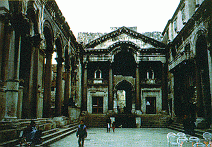


Diocletian, the Roman Emperor, decided to spend
his old age in the palace whose construction began
in 295 below Mount Marjan. The palace,
characterized by Roman-clear and functional ground-plan,
was, over the centuries, turned into a regular Middle Ages
maze, whereas Diocletian's mausoleum was turned into a
Christian cathedral, representing a unique blend of the
new, medieval and Christian (Croatian) culture rising on
the foundations of its antique predecessor. This
phenomenon of different styles and periods intertwining,
the turns of which are reflected in each palace's stone, is
the main reason why Diocletian's Palace and Split's medieval
core came to feature on the World Heritage List in 1979.
As a symbol of this evolving process, the St. Dujam
Cathedral's tower, recognizable from afar (St. Dujam being
among the first martyrs of the nearby Salona - the Roman
province of Dalmatia's capital), connects the old town's
silhouette with the new horizon made of Split's suburban
skyscrapers' towers. To preserve Split's imperial landscape,
threatened from all directions, and surrounded by urban
elementary powers of our times, represents the greatest
challenge for the generation celebrating the city's
foundation 1700th anniversary. Thus, while the origin of
Dubrovnik goes back to the anonimous architects of the
Middle Ages, Split has a well-known origin, characterized
by the imperial prestige.